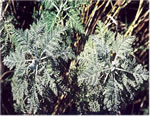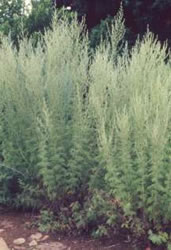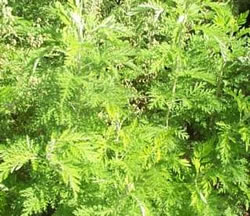Lengana

Artemisia afra is one of the oldest and best known medicinal plants, and is still used effectively today in South Africa by people of all cultures. Artemisia afra is a highly aromatic plant known as Wormwood or Sagewood (English); wildeals (Afrikaans); umhlonyane (Xhosa); umhlonyane (Zulu); lengana (Sotho). It an erect multi-stemmed perennial shrub of up to two metres in height and is widely distributed in Southern Africa. Lengana is one of the most widely used traditional medicines in Southern Africa. Numerous ailments are treated with it, mainly coughs, colds and influenza but also fever, loss of appetite, colic, headache, earache, malaria fever and intestinal worms amongst others. Lengana has also been used in natural insecticide sprays and as a moth repellent. World-wide there are about 400 species of Artemisia, mainly from the northern hemisphere. Many of the other Artemisia species are aromatic perennials and are used medicinally. Called wormwood due to its internal worm-expelling properties in the ancient Greek text of Dioscorides; Indians from New Mexico use similar varieties to treat bronchitis and colds; and the Chinese still use wormwood rolled up in the nostril to stop nosebleeds.
Description

Artemisia afra grows in thick, bushy, slightly untidy clumps, usually with tall stems up to 2m high, but sometimes as low as 0.6m. The stems are thick and woody at the base, becoming thinner and softer towards the top. Many smaller side branches shoot from the main stems. The stems are ribbed with strong swollen lines that run all the way up. The soft leaves are finely divided, almost fern-like. The upper surface of the leaves is dark green whereas the undersides and the stems are covered with small white hairs, which give the shrub the characteristic overall grey colour.
Growing

Artemisia afra flowers in late summer, from March to May. The individual creamy yellow flowers are small (3-4 mm in diameter), nodding and crowded at the tips of the branches. Very typical of A. afra is the strong, sticky sweet smell that it exudes when touched or cut. Artemisia afra needs full sun and heavy pruning in winter to encourage new lush growth in spring. Actively growing in the summer months, it should be able to take quite low temperatures during the winter months. Fast-growing, established shrubs are very tough and will slowly spread to form thicker clumps. New plants can be propagated by division or from cuttings that root easily in spring and summer. Seed can be sown in spring or summer.